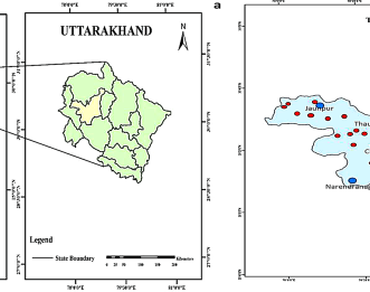Species richness and community dynamics of lichens across elevational gradients in district Tehri Garhwal, Uttarakhand
*Article not assigned to an issue yet
Research Articles | Published: 23 June, 2025
First Page: 0
Last Page: 0
Views: 862
Keywords: Elevational gradient, Lichen communities, Growth form, Representative taxonomic unit, Species richness
Abstract
Lichens make a substantial contribution to overall biodiversity. The distribution patterns of lichens were analyzed in relation to elevational gradients and their influence on lichen diversity. The study was done across elevational gradients ranging from 500 m to 2700 m consisting of three different biomes namely tropical, sub-tropical and sub-temperate regions. In our study, we utilized Generalized Additive Models (GAM) to analyze lichen species richness and growth form distribution patterns across an elevation gradient. This method offers a robust and taxonomically nuanced framework for exploring how environmental gradients such as elevation effect species richness. RTU1, RTU2, RTU3, RTU4, RTU6, RTU9, and RTU11 show significant relationships with elevation (p < 0.05). These RTUs have non-linear relationships with elevation, with the effective degrees of freedom (edf) > 1. A hump-shaped curve was observed for species richness in relation to elevation. Lichen diversity was documented for the area and dominant family was Parmeliaceae (26 species), followed by Physciaceae (19 species) and Caliciaceae (9 species) and Collemataceae (9 species). The current study identified 88 lichen species across 37 genera and 14 families in the Tehri Garhwal district of Uttarakhand. The hump-shaped distribution, with peak lichen richness at mid-elevations, emphasizes the ecological value of these zones and the need to consider elevational patterns in conservation planning.

References
Acharya BK, Chettri B, Vijayan L (2011) Distribution pattern of trees along an elevation gradient of Eastern himalaya, India. Acta Oecol 37(4):329–336. https://doi.org/10.1016/j.actao.2011.03.005
Baniya C, Bahadur, Solhøy T, Gauslaa Y, Palmer MW (2010) The elevation gradient of lichen species richness in Nepal. Lichenologist 42(1):83–96. https://doi.org/10.1017/S0024282909008627
Baniya CB (2010) Vascular and cryptogam richness in the world’s highest alpine zone. Tibet Mountain Res Dev 30:275–281
Baniya CB, Shrestha KK, Chongbang TB (2024) Patterns of lichen richness across elevation in the Manaslu conservation area, central Nepal. Nepal J Bot 16–24
Bhattarai KR, Vetaas OR, Grytnes JA (2004) Fern species richness along a central Himalayan elevational gradient, Nepal. J Biogeogr 31:389–400
Bhattarai KR, Vetaas OR (2003) Variation in plant species richness of different life forms along a subtropical elevation gradients in the himalayas, East Nepal. Glob Ecol Biogeogr 12(4):327–340. https://doi.org/10.1046/j.1466-822X.2003.00044.x
Boruah T, Dulal K, Das PN (2024) Ecology of Lichen. Chemistry, Biology and Pharmacology of Lichen 49
Gauslaa Y (2014) Rain, dew, and humid air as drivers of morphology, function and spatial distribution in epiphytic lichens. The Lichenologist. 2014; 46(1):1–16
Gauslaa Y, Palmqvist K, Solhaug KA, Hilmo O, Holien H, Nybakken L, Ohlson M (2009) Size-dependent growth of two old‐growth associated Macrolichen species. New Phytol 181(3):683–692
John E, Dale MRT (1990) Environmental correlates of species distributions in a saxicolous lichen community. J Veg Sci 1:385–392
Joshi S, Upreti D, Das P (2011) Lichen biodiversity across elevational gradient in Pindari glacier Valley of Uttarakhand. India 1(2):122–132. https://doi.org/10.5958/j.2231-1742.1.2.014
Kumar B (2009) Assessment of lichen species in a temperate region of Garhwal himalaya, India. J Am Sci 5(4):107–112
Kumar J, Khare R, Rai H, Upreti DK, Tayade A, Hota S, Chaurasia OP, Srivastava RB (2012) Diversity of lichens along altitudinal and land use gradients in the trans Himalayan cold desert of Ladakh. Nat Sci 10(4):1–9
Manish K, Pandit MK, Telwala Y, Nautiyal DC, Koh LP, Tiwari S (2017) Elevational plant species richness patterns and their drivers across non-endemics, endemics and growth forms in the Eastern himalaya. J Plant Res 130(5):829–844. https://doi.org/10.1007/s10265-017-0946-0
Naincy, Bhardwaj N, Bhatia A, Mishra GK (2024) Epiphytic lichen communities use as: A tool for assessing forest condition in Himachal pradesh, India. Biology Bull 1–10
Nanda SA, Haq MU, Singh SP, Reshi ZA, Rawal RS, Kumar D, Pandey A (2021) Species richness and β-diversity patterns of macrolichens along elevation gradients across the Himalayan Arc. Sci Rep 11(1):20155
Nayaka S, Ranjan S, Saxena P, Pathre U, Upreti D, Singh R (2009) Assessing the vitality of Himalayan lichens by measuring their photosynthetic performances using chlorophyll fluorescence technique. Curr Sci 97(4):538–545
Negi HR (2000) On the patterns of abundance and diversity of macrolichens of Chopta-Tunganath in the Garhwal himalaya. J Biosci 25(4):367–378
Nimis PL, Scheidegger C, Wolseley PA (2002) Monitoring with lichens—monitoring lichens: an introduction. Springer
Oliver I, Beattie AJ (1993) A possible method for the rapid assessment of biodiversity. Conservation biology. 7(3):562–568
Orange A, James PW, White FJ (2001) Micro-chemical methods for the identification of lichens. British Lichen Society, London, UK
Ponzetti JM, McCune BP (2001) Biotic soil crusts of oregon’s shrub steppe: community composition in relation to soil chemistry, climate, and livestock activity. Bryologist 104:212–225
Rai H, Khare R, Baniya CB, Upreti DK, Gupta RK (2015) Elevational gradients of terricolous lichen species richness in the Western himalaya. Biodivers Conserv 24(5):1155–1174
Spribille T, Resl P, Stanton DE, Tagirdzhanova G (2022) Evolutionary biology of lichen symbioses. New Phytologist 234(5):1566–1582. Evolutionary biology of lichen symbioses. 18 Mar. 2022. https://nph.onlinelibrary.wiley.com/doi/https://doi.org/10.1111/nph.18048
Upreti DK, Negi HR (1998) Lichen flora of Chopta-Tungnath, Garhwal Himalayas. J Economic Taxonomic Bot 22:273–286
Vetaas OR, Grytnes JA (2002) Distribution of vascular plant species richness and endemic richness along the Himalayan elevation gradient in Nepal. Glob Ecol Biogeogr 11:291–301
Walker FJ, Jame PW (1980) A revised guide to microchemical techniques for the identification of lichen products. Br Lichen Soc 46:13–29
Author Information
Department of Biosciences, Himachal Pradesh University, Summerhill, Shimla, India